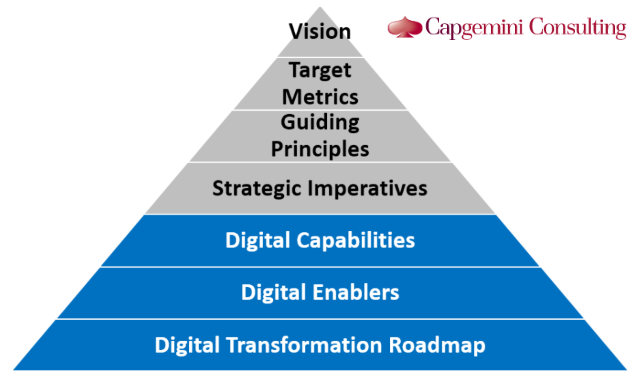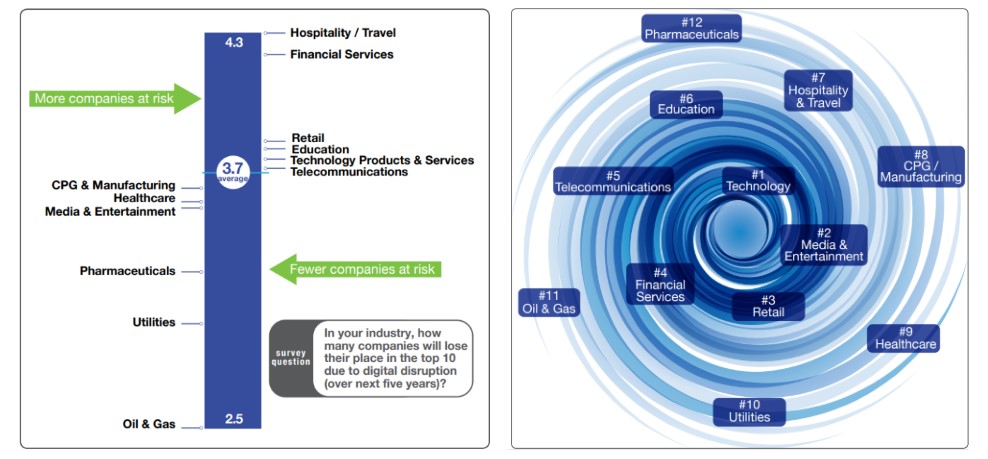In one of the Sherlock Holmes stories, Dr. Watson remarks about a client and how attractive she is. “Is she?” says the detective. “I didn’t notice.” In response to his partner’s quip that he really is a human automaton – lacking of emotion – Holmes replies that he is taking emotion out the equation, since it might compromise his detective work. Similarly, when it comes to selecting a digital transformation strategy, one must leave emotion behind and base the decision on what is best for the company.
According to Michael Wade, Professor of Innovation and Strategic Information Management, a successful digital transformation strategy requires the organization to ask itself three important questions:
- Why does the company need to transform?
- What do they need to do to transform?
- How can they transform?

Why does the company need to transform?
So, you review your company and take a look at the competition, and you say, “What this company needs is digital transformation.” It’s one thing to sense that your company needs that process, but you need to get down to the “nuts and bolts” of the idea: why does the company need it? Is the company’s technology outdated? Support staff inadequate to handle today’s demand for immediate replies? are the employees lacking in knowledge of today’s digital tools? How does the company stack against competitors who have, or in the process, of digital transformation?
What do they need to do to transform?
In what aspect does the company need to digitally transform: employee knowledge? Strictly technology upgrade? Enhancing the customer experience?
The fact is that each of these areas are all areas in which companies can digitally transform, and it is not limited to the above. As with overall digital transformation, the company that comes up with a disruptive way to digitally transform itself will be the industry leader and will set the pace for the rest of the market incumbents.
How they can transform?
The answer to the third question should contain the ingredients for the company’s strategic approach to digital transformation: not just how can the company digitally transform, but what is the optimal way for this particular company to transform? What is the objective of the digital transformation: to improve workflow efficiency and better customer experience, or give its customers an entirely new experience across the board? These questions are up to the CEO, CIO and or CINO to answer.
In order to remain competitive with the newer, digital-ready companies and start-ups, companies with legacy operations must take immediate action in order to remain competitive. Management who saw the digital transformation coming in advance and acted accordingly, have already taken action. As a result, digitally developed companies are four times more likely to provide employees with needed skills than companies less digitally inclined.

Says Professor David L. Rogers of Columbia Business School, “It’s easier to make that change when you see the disruption coming down on you. But it’s often too late at that point.” Even a cursory look at the business world can tell at a glance that companies from all types, whether tech, industrial, healthcare, banking and more, are immersed in the process, or have already completed the process of digital transformation.
The strength of digital transformation is not necessarily in the tech: it’s how the tech is used. Much like certain athletes, they can be on one team and not be very useful; however, insert them in another team, in another role, and they can be incredibly effective. This is what makes a brilliant sports manager, and this is what makes a good executive decision regarding digital transformation: finding the correct assets (not necessarily the latest technology) that can help vault the business forward, while keeping it flexible enough to evolve in the future.
It is a bit of irony that stability and methodical process and careful, advanced budget planning can be the exact opposite of what is required of companies today, but that is basically the landscape of today’s business world, where more and more companies are going through the digital transformation process in order to keep up with the latest innovations, to be ahead (or with) the competition, and not be left in the dust.
As it is already well known, a digital transformation strategy can have a decided effect on business – even sports teams use it to enhance fan experience, to ensure that whether the team is winning or not, they are enjoying a rich, interactive experience. Another example is Qmarkets’ customer, sporting goods giant Amer Sports, which embraced its new innovation management project by ensuring that employees would have access to the ideation platform from all areas, including designated “Idea Zones” stocked with tablets and mobile devices. Both these things would not be possible without a thorough digital transformation. But how did they get there?
Remember that digital transformation isn’t done for the sake of “going digital,” but to improve business results while bringing it into the digital age.
Choosing Your Digital Transformation Strategy – The Options

Upgrades/enhancements:
Is your company already digital ‘savvy?’ then perhaps a full transformation is not really required, only upgrades here and there; departmental training, etc.
Strategies like these are usually “reserved” for companies who already have digital fingerprints, so to speak throughout the business, and already have the digital know-how in all, or most, departments, from manufacturing process, to customer support and company culture.
As a simplified example, your customer support, which was done till now only via phone (during limited hours) and fax: surely, you’ll want to upgrade it to include social media response 24/7, direct contact to relevant professionals in the company, etc.
Another reason to choose this path is for when the company is in a business that is fluctuating and you always need to be ‘on the button’ to see what’s the next big thing to improve the business, and you don’t want to invest too much capital in a certain aspect that can easily be, in a short time, outdated.

Experimentation:
Not only internally, but externally. You can make changes till the cows come home, but if they’re not the correct changes, your strategy is in the soup. STC (Saudi Telecom Company) employed researchers to discover what millennials tick; the result was a new mobile brand. Setting up a company innovation lab; thinking up digital products that fit the company and its customers; cross-function collaboration between departments. And of course, testing your services with customers until you get it right – and by right, it means, the results your company (and the customers) are satisfied with.

Creativity
When a person says “let’s get creative,” it usually means the budget. Can also mean the personnel being hired, training, new equipment and of course, your business objectives. Additionally, where a company can get creative in strategy can also when it focuses he customer needs and “work backwards” to what the company offers presently and then determine what changes can they do to dramatically improve the customer experience across all available channels, and maybe new ones. At Daimler, for example, they went for the so-called “two-pronged” digital transformation strategy, optimizing digital services for its customers as well as its employees. Additionally, it organized an external hackathon which took place not at the company, but at an international auto show.

“For Daimler, digitalization is the biggest enrichment since the invention of the automobile.” – Dr. Dieter Zetsche, Chairman of the Board of Management of Daimler AG and Head of Mercedes-Benz Cars.

Security
While the lack of a digital transformation strategy can be a major stumbling block to stablished companies, younger, developing companies cite security concerns as a priority. Depending on the company’s expertise, location, customers, publications, etc., it may be worth putting security as the number one priority concern in your digital transformation. For instance, you’d love all your employees to use a new CRM or emailing system, but how secure is it? When you choose a cloud technology to backup your data, how well defended is it from hacking, or simply collapsing?

Modularity:
This is a long-term and heavy investment strategy. Bearing in mind that the pace of technological and/or digital changes will become faster than it is today, it begs the questions how far would you be willing to invest, or how patient you will be, to extract and to use large amounts of data to come up with innovative and effective new capabilities. These can thoroughly transform the departments in the company, making them adaptive to potential technological advancements. You will also have to consider taking part of the growing digital “ecosystem” of companies that allow products, services or platforms to work together in one way or another, as part of a business strategy to provide the optimal customer service.
Once, it used to be that a company would be set up, grow, mature and become established and, if run correctly, be successful. Today, the “established” seems to have been replaced with “evolving,” as the continuous development of new technologies and digital transformation. Companies will need to get creative not out of choice – but out of necessity. To paraphrase the famous quote, “necessity is the mother of digital transformation.”
When it comes to digital transformation strategies, agility, flexibility and collaboration are key components for a successful process. As a leading provider of collective intelligence solutions for enterprises, Qmarkets offers you the choice of a number of all-inclusive, fully customizable solutions that can assist in building up your company’s digital transformation process, from the start to finish, thanks to powerful, innovative and easy-to-manage tools such as Q-Hack, a unique, collaborative intelligence tool, that can be integrated with a company’s innovation management platform; Q-Live innovation workshop, Q-max, an innovation management platform, and Q-Open, an idea management platform. The combination of all suites gives you the optimal solution for a smooth digital transformation.
To learn more about how Qmarkets can assist your digital transformation strategy, leave your details and one of our associates will get back to you:
